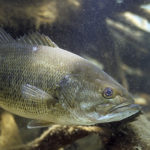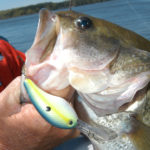
Lack of oxygen will push fish out of deep areas
I know this is really going to sound unusual, but if you’re going to catch bass from most of our lakes in North Carolina in August, you’d better be prepared to fish shallow.
It’s been hot all summer, we haven’t had much rain, so there’s not much current, and that’s a perfect prescription for our lakes not carrying much dissolved oxygen. Bass can stand hot water, but they can’t stand water that isn’t carrying any oxygen, and that’s what we’re in for, unless something happens to change it — like a tropical storm.
I think we’re going to catch most of our bass this month in 10 feet of water or less, and a lot of them will be 6 or 7 feet deep.
Most bass fishermen know that when summer arrives and it gets hot, a lot of our lakes develop a thermocline, which is an imaginary dividing line that separates the cooler water that doesn’t carry much dissolved oxygen, is heavier and sinks to the bottom, and the warmer, better oxygenated water toward the surface. If you turn up the sensitivity on your depthfinder or flasher, you can sometimes get a reading on the thermocline; it will be a horizontal line off the bottom.
Bass and other fish like stripers, crappie and catfish will usually live right around that thermocline, usually just a foot or so above it, so they can take advantage of the oxygen in the warmer water while being closer to the cooler, deeper water. They can trade back and forth easily between the two areas.
As it gets hotter and there’s less oxygen in that deeper water, bass will closer to the shallows. This happens a lot on my home lake, High Rock, toward the end of August. The bass will all pull up around the boat docks after being 18 or 20 feet deep in July and early August. Then, it seems like we’ll get some good rain and we’ll get more current in the water and they’ll go back deeper.
You’ve gotta have flowing water, some good current, to get more dissolved oxygen in the water. If you go fish a lake where they’ve had some rain in the area and there’s some current, fishing is going to be different, but around here, I think they’re gonna be shallow.
Since we’re stuck with them shallow, we might as well catch them. They’ll be in some of the same places they are when they’re in a springtime pattern, but they’ll be scattered out: one or two here and one or two there. They’ll hit a crankbait — square-lipped baits are pretty good choices — and they’ll hit a worm like a Zoom Magnum Finesse worm or a creature bait like a Zoom Baby Brush Hot, and they’ll hit a Fat Raz spinnerbait or jig, but a lot of times, you’ll have to make multiple casts to the same dock or brushpile to get them to bite.
If you’re fishing a crankbait, you want something that will get you down in that 6- to 10-foot range; Ed Chambers’ Zoom crankbaits are good, and a Killer B-2 can be really good. When you get to August and September, chartreuse becomes strong, so Homer is a great color, as well as blue/pearl and green/pearl. These aren’t big baits, and you’re not trying to get them real deep, so you don’t need to fish ‘em on a real long rod. I use a 7-foot, medium-heavy Lew’s David Fritts Cranking Stick, a Lew’s BB-1N reel and 10-pound Vicious mono — I think it’s the best line for fishing crankbaits since Prime Plus was out 20 years ago.
A couple of things you can do is look for areas where the lake narrows up, because there will usually be a little more current there, or you can go up and fish in the river. When fishing is really tough in the lake, you can always go up in the river or go to the backs of the creeks and scrounge out some fish, because those fish stay shallow all year and they’re used to the hot water. You can go up there and fish a little deeper, but you may be fishing out past them; that’s been one of my problems in August; fishing too deep when they’re on the bank.
A good thing to remember is, because the water is so hot, fish are liable to be sluggish. When they’re feeding, they can be aggressive, but when they’re not, it might take 20 or 30 casts to a spot to get one to bite. The other thing is, you need to be fishing early or late; those are the times they bite best. At dawn, that’s when the water is the coolest it’s going to be all day and when they’ll be the most aggressive.
So don’t head to the lake this month with nothing but a Carolina rig and a deep-diving crankbait. Understand that water conditions will push fish into places you normally wouldn’t look for them. Make sure you do.






Be the first to comment